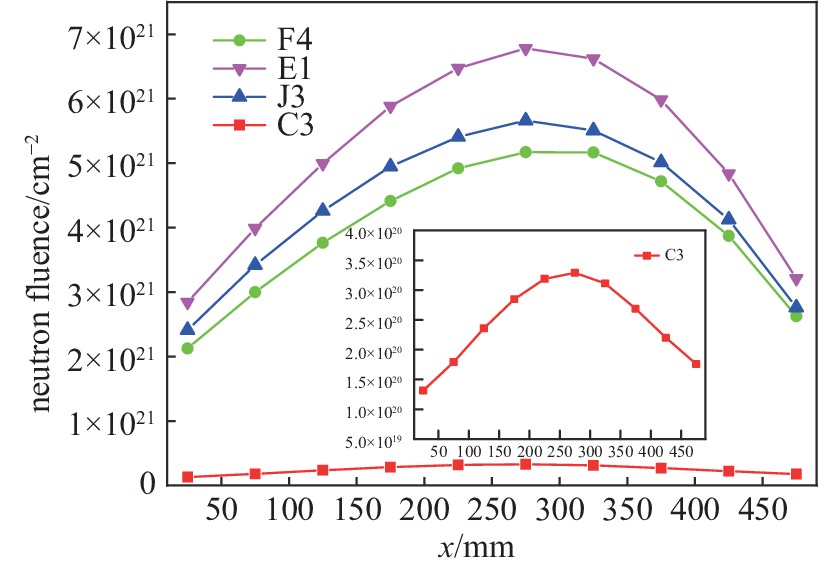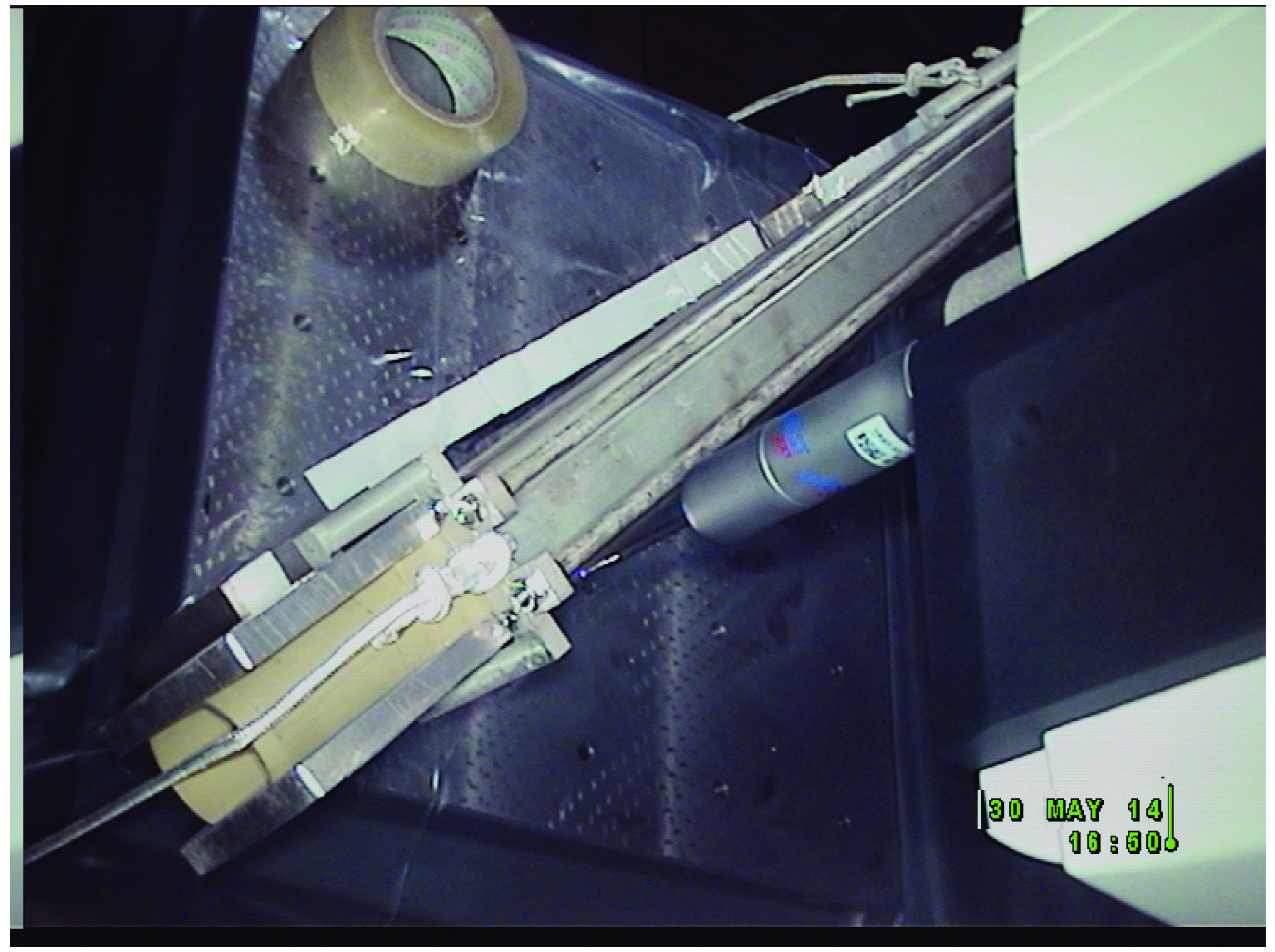Size measurements of beryllium assemblies after long term service
-
摘要: 铍是核反应堆内的重要反射层材料,其辐照后的尺寸变化对反应堆的安全性具有重要的影响。为获得铍组件堆内长期服役后的尺寸变化,以对其堆内的服役性能评价提供基础数据,设计并加工了一套高放样品远程转运平台,使用三坐标测量机完成了绵阳SPRR-300堆内铍组件的尺寸变化测量实验。实验测量结果表明,SPRR-300堆的铍组件在服役29 a后,在最高中子通量高达6.78×1021 cm−2的辐照环境下,铍组件外形尺寸总体上保持良好,截面有微量的收缩变形,最大形变约0.13 mm,这表明在长期中子辐照环境下,辐照蠕变是导致铍组件尺寸变化的主要原因。Abstract: Beryllium is an important material as neutron reflection layers in nuclear reactors. The size change of beryllium after long term neutron irradiation has a great influence on the reactor safety. To obtain the size change of beryllium assemblies after long-time irradiation for the assessment of service performance, a set of special tools were designed and manufactured. The size change of post-irradiation beryllium assemblies was examined on a three coordinate measuring machine. The measurement results indicate that beryllium assemblies of the SPRR-300 reactor have excellent stability after 29 a irradiation, even under the maximum neutron fluence of 6.78×1021 cm−2. The section dimension has little change in local part of beryllium assemblies and the largest change is about 0.13 mm, which indicates that irradiation creep is the main reason for the dimension change of beryllium assemblies during the long-time service.
-
Key words:
- SPRR-300 reactor /
- beryllium assemblies /
- neutron irradiation /
- long term service /
- irradiation creep
-
表 1 测量所用铍组件的服役时间与最大中子注量
Table 1. Service-time and maximum neutron fluence of beryllium assemblies
No. service-time/a service duration maximum neutron fluence/cm−2 C3 14 1995—2008 3.29E+20 F4 29 1979—2008 5.17E+21 J3 29 1979—2008 5.66E+21 E1 29 1979—2008 6.78E+21 表 2 铍组件的平面度
Table 2. Plane degree of beryllium assemblies
No. the average neutron fluence of measuring position/cm−2 xz/mm −xz/mm +xy/mm −xy/mm C3 2.68E+20 0.061 2 0.004 5 0.056 3 0.047 8 F4 4.33E+21 0.120 2 0.000 4 0.132 8 0.119 8 J3 4.71E+21 0.059 8 0.020 3 0.071 7 0.107 4 E1 5.60E+21 0.025 1 0.000 1 0.059 7 0.060 0 Note: the x-axis, y-axis and z-axis parallel the direction of length, width and height, respectively. 表 3 铍组件辐照前后的截面尺寸
Table 3. Section of beryllium assemblies
No. the average neutron fluence of
measuring position/cm−2width/mm height/mm the average distance of
width and height/mmdeformation
degree/mmoriginal 0 67.850 0 67.850 0 67.850 0 0 C3 2.68E+20 68.123 8 68.008 3 68.066 1 0.216 1 F4 4.33E+21 67.435 3 68.046 1 67.740 7 –0.109 3 J3 4.71E+21 67.463 8 67.457 2 67.460 5 −0.389 5 E1 5.60E+21 67.533 9 67.887 4 67.710 7 −0.139 3 -
[1] 单润华, 王日清, 李满昌, 等. 高通量工程试验反应堆铍孔道在辐照上的综合利用[J]. 核动力工程, 1983, 4(5):7-15. (Shan Runhua, Wang Riqing, Li Manchang, et al. General uses of the holes in beryllium slugs in HFETR on irradiation[J]. Nuclear Power Engineering, 1983, 4(5): 7-15 [2] Hoyer A. Lifetime analysis of irradiated beryllium in research reactors[D]. Columbia: University of Missouri, 2017: 1-10. [3] Snead L L, Zinkle S J. Use of beryllium and beryllium oxide in space reactors[J]. AIP Conference Proceedings, 2005, 746(1): 768-775. [4] Nie Y, Ren J, Ruan X, et al. The benchmark experiment on slab beryllium with D-T neutrons for validation of evaluated nuclear data[J]. Fusion Engineering and Design, 2016, 105: 8-14. doi: 10.1016/j.fusengdes.2016.01.049 [5] Harmsen A G, Hoover M D, Seiler F A. Health risk implications of using beryllium in fusion reactors[J]. Journal of Nuclear Materials, 1984, 122(1/3): 821-826. [6] Gelles D S, Heinisch H L. Neutron damage in beryllium[J]. Journal of Nuclear Materials, 1992, 191/194: 194-198. doi: 10.1016/S0022-3115(09)80032-9 [7] Nankov N, Troev T, Petrov L, et al. Positron lifetime calculations of defects in fusion irradiated beryllium[J]. Nuclear Instruments and Methods in Physics Research Section B: Beam Interactions with Materials and Atoms, 2008, 266(15): 3392-3396. doi: 10.1016/j.nimb.2008.03.240 [8] Ishitsuka E, Kawamura H. Beryllium neutron irradiation study in the Japan materials testing reactor[J]. Fusion Engineering and Design, 1998, 41(1/4): 195-200. [9] 王文利. 重水堆燃料铍材国产化及入堆验证试验[J]. 核动力工程, 2015, 36(5):208-210. (Wang Wenli. Beryllium localization and verification test of PHWR fuel[J]. Nuclear Power Engineering, 2015, 36(5): 208-210 [10] 张松宝, 杨万奎, 窦海峰. SPRR-300堆寿期后关键结构材料辐照注量的理论计算[R]. GF-A0183454G, 2013Zhang Songbao, Yang Wankui, Dou Haifeng. The integral flux calculation of the structural of No. 300 reactor after commission[R]. GF-A0183454G, 2013 [11] 杨万奎, 曾和荣, 冷军, 等. 300#研究堆首炉中央孔道中子通量密度计算[J]. 强激光与粒子束, 2012, 24(12):3001-3005. (Yang Wankui, Zeng Herong, Leng Jun, et al. Neutron flux calculation for central channel in first cycle of SPRR-300[J]. High Power Laser and Particle Beams, 2012, 24(12): 3001-3005 doi: 10.3788/HPLPB20122412.3001 [12] 李婷婷. 铍和氧化铍电子、弹性性质的第一性原理计算[D]. 银川: 宁夏大学, 2015: 1-20Li Tingting. First principle calculation of electronic and elastic properties of beryllium and beryllium oxide[D]. Yinchuan: Ningxia University, 2015: 1-20 [13] Savino E J, Laciana C E. Radiation induced creep and growth of zirconium alloys[J]. Journal of Nuclear Materials, 1980, 90(1/3): 89-107. [14] Chakin V P, Posevin A O, Оbukhov A V, et al. Radiation growth of beryllium[J]. Journal of Nuclear Materials, 2009, 386/388: 206-209. doi: 10.1016/j.jnucmat.2008.12.097 [15] Scaffidi-Argentina F. Tritium and helium release from neutron irradiated beryllium pebbles from the EXOTIC-8 irradiation[J]. Fusion Engineering and Design, 2001, 58/59: 641-645. doi: 10.1016/S0920-3796(01)00510-5 [16] Möslang A, Pieritz R A, Boller E, et al. Gas bubble network formation in irradiated beryllium pebbles monitored by X-ray microtomography[J]. Journal of Nuclear Materials, 2009, 386/388: 1052-1055. doi: 10.1016/j.jnucmat.2008.12.258 [17] Kupriyanov I B, Melder R R, Gorokhov V A. The effect of neutron irradiation on beryllium performance[J]. Fusion Engineering and Design, 2000, 51/52: 135-143. doi: 10.1016/S0920-3796(00)00306-9 [18] Chakin V P, Kazakov V A, Melder R R, et al. Effects of neutron irradiation at 70-200 ℃ in beryllium[J]. Journal of Nuclear Materials, 2002, 307/311: 647-652. doi: 10.1016/S0022-3115(02)01218-7 [19] Snead L L. Low-temperature low-dose neutron irradiation effects on beryllium[J]. Journal of Nuclear Materials, 2004, 326(2/3): 114-124. 期刊类型引用(2)
1. 陈锶,高杨,任万春,彭春瑞,王姮. FeGaB磁性薄膜中涡流损耗抑制方法的仿真. 压电与声光. 2020(03): 357-360 .  百度学术
百度学术2. 古亮,谭清月,张腾翼,帅潇潇,王帅. 电子束二极管脉冲磁场的涡流分析及抑制. 强激光与粒子束. 2019(01): 72-78 .  本站查看
本站查看其他类型引用(3)
-






 下载:
下载:






